Laurie Latour, author of The Guide to Gingham Embroidery: Book One – Stitch & Learn Gingham Lace, Snowflaking, & Gingham Cross Stitch, is guest posting here today. Laurie’s an avid collector of gingham embroidered aprons and an expert on the subject of All Things Gingham-Embroidered. I hope you enjoy her article!
Ah, the long lazy days of summer, a time to dream and play and have fun. Or so it was when we were kids. Now, maybe not so much. I don’t know about you, but there’s still a playful little kid inside me yearning to be set free. Free to explore, imagine, and well, just have fun.
These are the very prerequisites for creativity: giving that inner child permission to play, time to dream without the clamor of endless To-Do lists, and freedom to explore without the fear of making a mistake. That applies to our needlework as well as any other creative endeavor.
As we play and try out something new with needle and thread, why not invite a child to join you? Or perhaps an adult who never learned to sew, much less to embroider. Approach needlework as a fun time together, rather than an intimidating endeavor.
My hobby, collecting gingham embroidered aprons, became a call to creativity and has sparked many ideas to try new designs and threads in my needlework. My display of vintage aprons has changed me from someone content to always follow a pattern, to a more adventurous soul who now delights in playing with needle, thread, and fabric. After all, what do I have to lose? A bit of gingham and some floss is not a huge investment, but it is the “perfect playground.”
The aprons also inspired me to teach gingham embroidery to young and old. Because it is easy to learn, and needs only a few inexpensive supplies, most people are willing to give it a try and are pleasantly surprised that their needlework efforts are quickly rewarded.
So on this breezy summer’s day, let me share with you some of the embroidered aprons that inspire me.
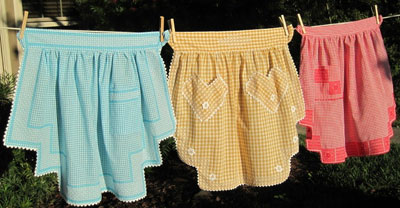
I love these stair step hemlines; they add interest and make a basic apron something special. The butterscotch apron is decorated with basic cross stitch, and the needle worker had a bit a fun creating those little round motifs by stitching bits of wide rick-rack into a circle. The pockets really caught my eye! I love the unusual shape, and the way they are cut on the bias, and then applied to the straight grain of the apron. Something in me likes to rebel, at least occasionally, to the admonition to always match the lines in your fabric!
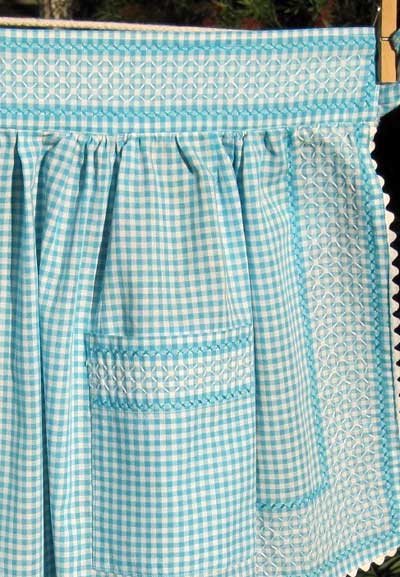
The turquoise apron is beautiful in its simplicity. Darker cross stitching frames the white half crosses which accent the white checks in the fabric to create a pretty design. A novice needle worker could easily stitch this on a tablecloth, placemats, an apron, or for a really quick project, a bookmark.

The red apron is decorated with blocks of cross stitch and double rows of running stitch (left).
What looked like ordinary blocks of cross stitch revealed a more detailed design; woven crosses adorn the center of every other block (right). Floss was woven over several stitches on top of the fabric to create the cross.
Stitches on aprons don’t always look nice and neat. They have, after all, been worn, loved and laundered! The blocks of stitching are still quite attractive, and a design element you see often in gingham embroidery.
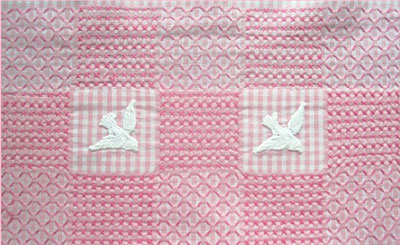
In this apron, blocks of cross stitch alternate with blocks of half cross stitch. The needle worker stitched white dove appliqués to the plain gingham squares to add her own unique touch to the apron.
These block patterns remind me of quilt patterns. Hmmm, why not stitch blocks in different colors, a Sunshine and Shadow design perhaps? A project for another day…
While cross stitch is great for beginners, there is so much more to Gingham Embroidery. Many people are unaware that you can create beautiful Gingham Lace. I hope you’ll try it.
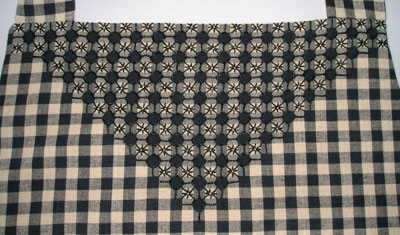
On this apron, I stitched what is called Reverse Gingham Lace Stitch, weaving pearl cotton around the dark checks in the fabric. Traditionally this stitch is worked around the white checks (beige in this homespun). But I like the more dramatic look you get working it in reverse as I did on the top of this apron.
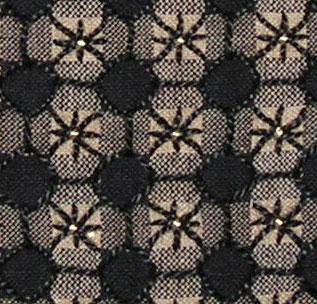
To add a little sparkle to the dark fabric, I considered beading but decided to save that for a smaller project. Instead, I stitched tiny running stitches over the snowflakes with rayon floss.
To inspire you to explore all the possibilities of Gingham Embroidery, I must share one more apron from my collection.
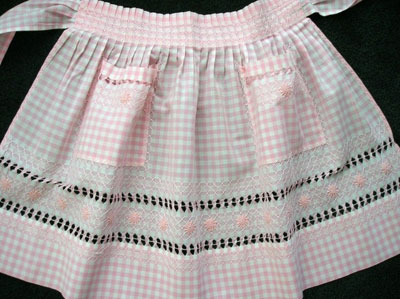
Someone spent many hours creating this beauty from the perfectly pleated waistband to the drawn thread work on the apron and the pockets, plus eighteen woven spider web motifs!
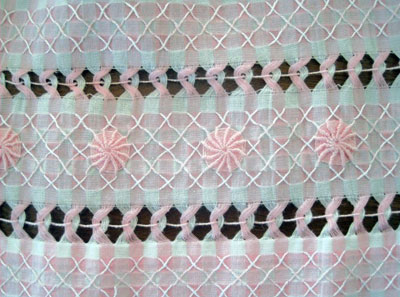
Mary has written an excellent tutorial on drawn thread work on gingham and she’s done a how-to video on the ribbed spider web motif.
Whether it’s basic cross stitch, drawn thread work, or needle weaving, I hope you’ll try your hand at Gingham Embroidery and invite someone to join you as you play!
You’ll find detailed photos and instructions in my ebook, “The Guide to Gingham Embroidery, Book One”. See Mary’s review here.
Thanks to Laurie for writing today’s post, and for showing us these darling gingham embroidery aprons and pointing out the all the pretty details. Hope you all enjoyed it!
Any questions or comments – feel free to leave a comment below! Enjoy your weekend!







Years ago I made a little dress for my DD with gingham and embr. I had forgotten all about it! my DH’s grand mother taught me how to do it and it was so easy and sweet. I had little babies and not allot of time. Thank you so much for the memory re fresher… I can’t believe people are still interested in the old things…. but that’s what she said to me more than 35 yrs ago!
I remember that one of the earliest pieces that I ever sewed was a gingham apron made in elementary school. I must have been about 8. The apron was blue, the whole thing hand sewn together and then embellished with cross stitch embroidery. I wish I knew what happened to it!!
You have a lovely collection! I have a small collection of antique aprons, but only one is gingham. I am familiar with kind of work, one of my first pieces of needlework was on a scrap of red gingham that I stitched a flower on. I still have it! Grandma had me do this to start, then advanced me to a pillowcase. I know this work as ‘Chicken Scratch’. I have always liked the many lacey designs that can be accomplished on gingham. I think I will need to get a copy of your book!
These are absolutely beautiful. I did some embroidery on Gingham when I was in school. Must check if my mom still has it.
When I first heard of gingham embroidery/chicken scratch — and that was maybe a month ago — it felt sort of boring, working on a dull checkered cloth (stripes and dots aren’t my thing). But these pretty aprons really show how pretty it can be and how one can work with the squares and create something that doesn’t feel like just, well, squares. The embroidery alter the fabric, but also the squares are so important for the embroidery. Hard to put in words, but it’s something about the “interaction” between simple embroidery stitches and the pattern in the fabric. I feel sort of inspired by this lovely collection of apron. Perhaps I’ll give it a try anyway, now that I see more of the potential in it.
(It’s almost like with me and anundsjösöm. Don’t really like it, but then I look closer at the anundsjö stitch and I want to give it a try anyway.)
I think I just feel in love! I must try the gingham lace like your black and white piece. That would make a lovely bodice to a spring dress.
I’ve seen some people mention that 100% is hard to find and I’m wondering as long as it’s woven and not printed (so both sides are the same) does it matter if it’s a blended fabric?
Thank you!
I meant to say “100% cotton” fabric.
Thanks again!
Thank you for sharing some of your collection of aprons, they are lovely. Your book is now on my must have list. I have been inspired.
Brought back some wonderful memories…
Thank you,
Annie in Michigan
Judy, it’s not too hard to find 100% cotton gingham (and homespun is always 100% cotton as far as I know). Fabric.com has some as does Hancocks online. Look in the “Ask & Share” tab at the top of the page – in the first Q & A section, I posted the links and someone else posted another. But to answer your question, you can use poly-cotton blends, no problem! Although I love the all cotton, there’s much to be said for the poly-cotton as it comes in an array of bright colors and wrinkles less than all cotton, dries quickly, and I think it feels crisp.
I also have some aprons in my collection that were made with printed gingham (rather than woven). I saw some printed ginghams in JoAnn’s just today and they were in more unusual, and pretty, colors. You can embroider on them, too. It’s not my first choice, but if the color of the fabric is something I especially want, I would use it. Gingham embroidery is really quite flexible, so go ahead, experiment, and enjoy!
Laurie
Nice collection. I remember sitting with my grandmother doing some “gingham” stitches. She also used to do some interesting smocking stitches on gingham, as well. I recently made some black & white gingham curtains for the kitchen and found some gorgeous 100% cotton gingham fabric. So it is still out there. Thanks for the article.
Years ago, I read an article about your future homemakers club, and the gingham lace bookmarks you made with them. It gave me inspiration when I became a mother and could find so little time for needlework, to make little embroidered bookmarks for a small sense of accomplishment. I still have gingham lace on my to-learn list.
Wow! This is on my list of must tries! Beautiful. Thanks for sharing.
Many, many years ago I went through a “Chicken Scratch” phase. I had completely forgotten about it until reading your article. Thanks for bringing back the memories. I spend more time writing these days than sewing, but if I ever wanted to get back into sewing, this is certainly something I would consider giving a try again.
Thanks for the beautifully written article, and the pictures of the gorgeous aprons.
Thanks for sharing! Your apron collection is lovely and an inspiration!
Carla
Well, it’s not aprons, but many years ago, I made an embroidered gingham baby quilt for my youngest son – the kit called it Teneriffe Lace. Decades later, after many many washings, it still looks fresh and new. (When he moved from home, he took his quilt with him!) I recently found the kit instructions and have been thinking I need to get some gingham and …
Hello Mary ~
My Grandmother use to do the embroidery on Gingham/Chicken Scrath
I would love to have Laurie’s E-book.
I have gone to the site that you gave on June 6th many times, without any success – all information is covered over; even the CONTACT US is not accessable??? any advise to obtain the E-book, or would you have Laurie contact me. Her aprons are so pretty, I would love to make some for Christmas gifts.
Thank you and thanks to Laurie
I enjoyed your article. I have stitched on gingham off and on since the 70’s. You will find more information and even some patterns if you look up chicken scratch. This was the name they used then because the back of a stitched pieced was messy like chicken scratch —
Sharon, I am so sorry you are having trouble accessing my Gingham ebook. The site that carries it requires Internet Explorer 8 (or above) and does not support older browsers. It’s not my site, but I have reported the problem to their webmaster. You can update, free, to IE 8 at microsoft.com, or e-mail me to make other arrangements. FutureChristianHomemakers@gmail.com
Blessings to you!
Laurie
These aprons reminded me of my childhood when we got aprons as gifts for serving at wedding showers. I always got one that matched my mom and took them for granted until now when I can’t find them or have to make my own. My bbright green gingham with the cross stitch hems and waist band would have fit right into your collection. Unfortunately, I have no idea what happened to them, although my guess is they went out when Mom cleaned out her closet.
I love the gingham aprons!
Especially the stair stepped one with rickrack trim.
If you don’t mind telling me is the rickrack sandwiched in a facing or simply sewn on? I’m wondering about the finishing details of the apron.
Thanks so much!
Kathy Holmes
I want to make one for my son’s engagement party which has a fifties theme.
Dear Mary,
Not sure this will go through as i’ve procrasitnated too long. But, I wanted to say that i worked in a shop a long time ago and this embroidery was called Teneriffe Embroidery and we did a lot of it….fun
Such awesome inspiration. Love how the detail really sets it off. The pockets on the butterscotch and the teal and black and white apron, wow!
Heather
Just love!!! Do you have any gingham Christmas designs for sale?
Hello – today I did a short blog post talking about “chicken scratch” and I used a photo from your post here. I just tested all the links to your blog and to this post. they are working.
Would you please visit and let me know if you have objections/corrections … i am new at this and want to attribute sources correctly.
http://www.threeoldkeys.blogspot.com/2012/01/got-chicken-scratch-itch-again.html
thank you … what a beautiful blog you have !!! it makes me itch to stitch for sure.
laurie selmer
threeoldkeys
LOVE the aprons. Please show more! Amazing handwork. I have a few gingham aprons myself, but yours – WOW!!! I would like to learn to do the chicken scratch myself. Suggestions?
I would like to have patterns on the chicken scratch embroidery, particularly the turquoise one above.
Is that possible?
My sisters and I just discovered about 6 gingham aprons with various gigham embroidery patterns done on them while going thru my mother’s house after her death. Some are stained but some are in good condition. I hope to take pictures of them to keep the patterns so I can play with them later. I enjoyed the post on the gingham embroidery.
Thanks,
Melissa
Thank you for sharing, I really appreciate this information! I have been collecting these Related items for years.
The hard work of these anonymous women lives on in your sharing their work and I have learned from this blog post. Thank you for sharing these cherished art works with us. Hopefully they will live on to inspire others to pick up their own needles and create a new work of art that will live on long after them!
I do have a quick question for you. Do you usually use pearl cotton or DMC floss for your own work? I have a yard of small block homespun and I want to create a little apron with it. I normally work on higher count cross stitch fabrics, so I’m not afraid of the small blocks in the fabric (it’s approximately 5-6 blocks to the inch, for reference). I don’t have the correct ombre floss in my DMC floss collection, but I’m toying with the idea of using blended DMC floss to get the correct colors. What is your opinion on both the DMC floss and pearl cotton? Is one better than the other for durability or working the pattern? I’d love to hear your thoughts on this. Thank you in advance.
~Diane
Hi, Diane – I think you can use regular floss without a problem. I would guess that perle cotton would hold up better, in a sense, because it is a stronger, more tightly twisted thread, but I think floss would work fine, especially on smaller squares.